Best cheap MTB pedals 2025 – top-rated flat and clipless options that won't break the bank
Our pick of the best cheap MTB pedals you can buy, whether you're looking to go flat or clipless on the trails
Making a saving with the best cheap MTB pedals doesn't have to mean compromising on quality. This is one piece of your mountain bike setup where there are plenty of excellent lower and mid-tier options, meaning you can get kitted out without breaking the bank.
Whether you're looking for the best clipless or flat MTB pedals, many of the best and cheapest MTB models are among the most reliable on the market. The perennial Shimano PD-M520 has been going strong since 2004, yet we believe it's still one of the most durable and best-value pedals you can buy.
As with most MTB-related products, your choice is going to come down to personal preference, whether you're looking for a clipless pedal for more efficient riding, or a flat pedal more suited to hitting gravity-orientated runs. Our guide to the best cheap MTB pedals contains options for multiple types of riding, along with a quick guide to what for look for when buying a lower-budget pedal.
If you're after something to wrap your feet in as well as put your feet on, you may well be interested in our guides to the best mountain bike shoes and best MTB flat pedal shoes.
The best cheap MTB pedals
Why trust BikePerfect
Flat pedals
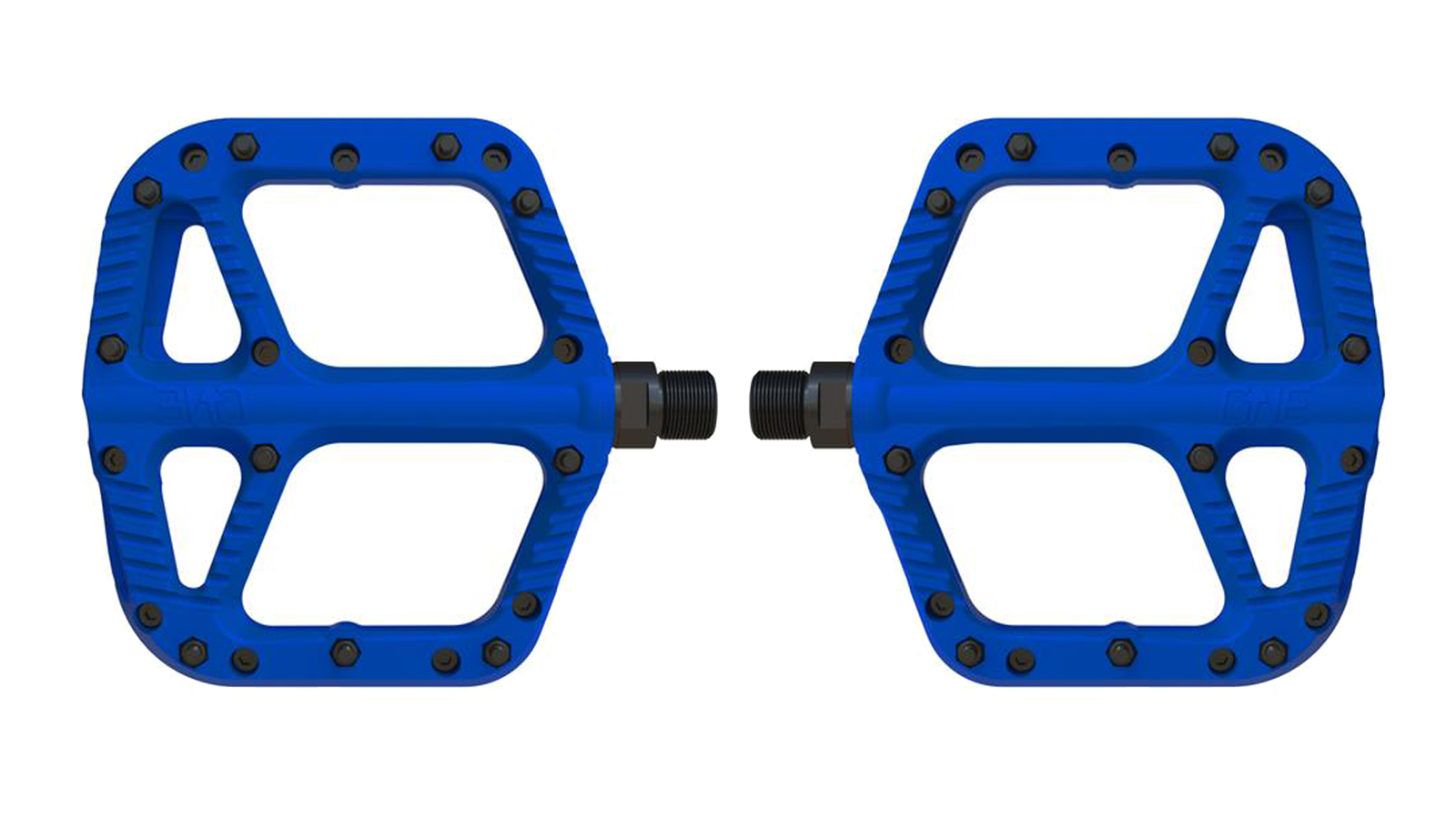
OneUp Components Composite
Specifications
Reasons to buy
Reasons to avoid
OneUp Components makes a great aluminum flat pedal with ample platform size and pin distribution. Remolding it in nylon-composite dramatically drops the price without sacrificing any of the pedal's attributes. In fact, the Composite pedals are one of the lightest pedals on our list. The composite body isn't as stiff as some of its alloy rivals, which helps dull impacts on rough terrain.
A wide platform has a thin leading edge thickness, 18.5mm at the axle and reducing to 13.3mm, which gives you a terrifically stable platform from which to pedal. The 10 pins are well distributed across the platform and there are textured ridges to help with traction in the wet.
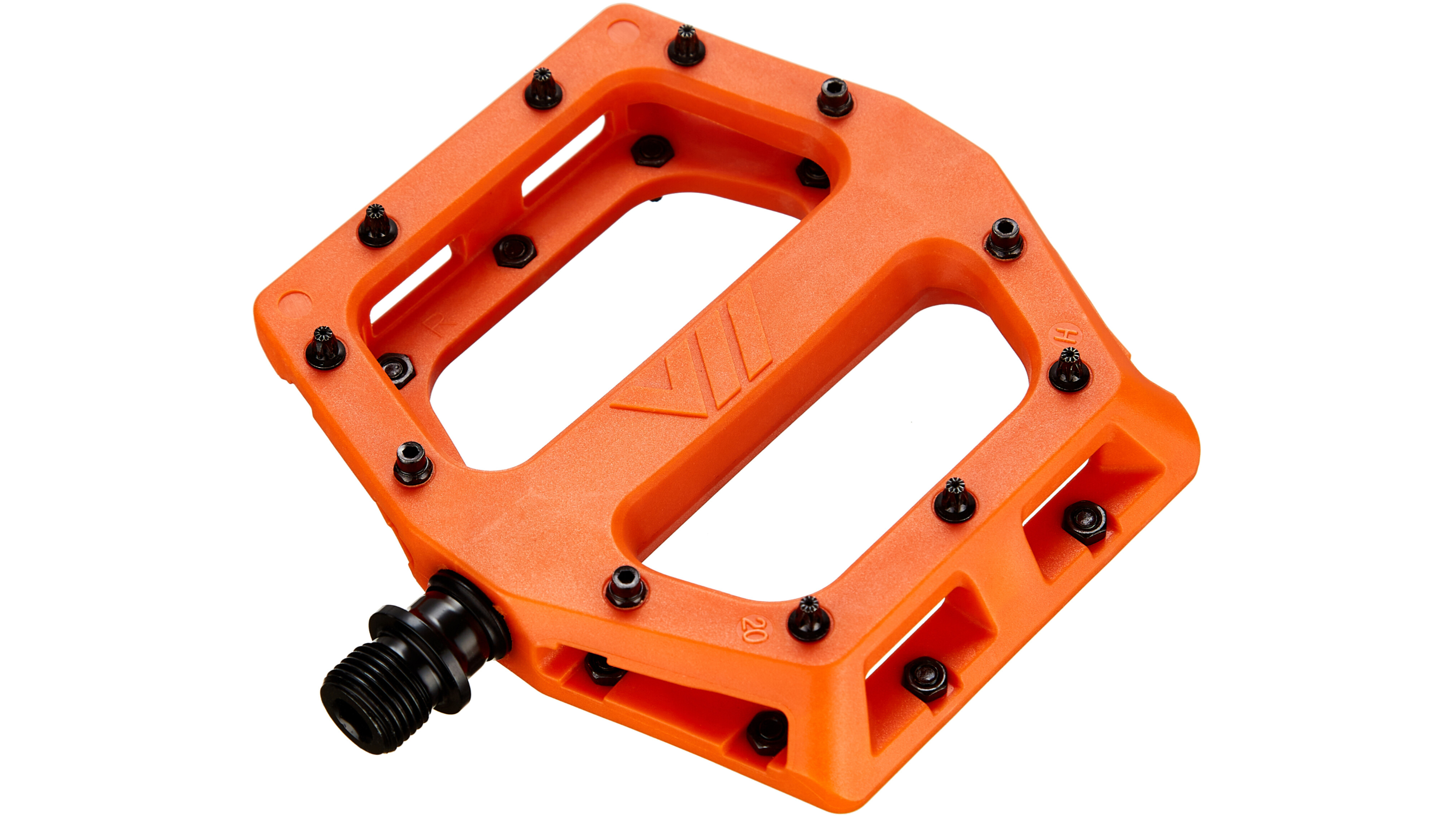
Specifications
Reasons to buy
Reasons to avoid
The 105mm x 105mm platform of the V11 is the same as DMR's popular alloy Vault as well as the signature DMR concave profile to enhance platform grip. The only difference is pedal thickness, with the nylon construction adding an extra 3mm of thickness to enhance the strength. The foot-centering shape is adorned with 11 replaceable/adjustable steel pins on each side, with a collection of longer ‘Moto’ pins front and rear for maximum grip.
The best thing we can say about the V11s is that most riders will be hard-pressed to tell them apart from their metal rivals. While the plastic platform is a little slippier in the wet, the flexible construction can improve connection and reduce foot tiredness on relentlessly battering runs. The pedals are also serviceable, with DMR offering bearing kits and replaceable pin sets.
For more information on how they perform on the trails, read our full review of the DMR V11 pedals.
Clipless pedals

Specifications
Reasons to buy
Reasons to avoid
One of the most wondrous things about the Shimano PD-M520 pedal is that it’s pretty much unchanged since its original release in 2004. This is the ultra-reliable, ultra-affordable SPD that works for everyone – both a classic first-time clipless pedal and a classic tough-riding all-rounder.
The humble PD-M520 shares many of its basic design features with its more sophisticated brothers, just with a little less finesse and weight saving. The body is a little chunkier, the axle is thicker and a little heavier, and it uses a plastic lockring rather than a metal nut, but, like the rest of the range, the PD-M520s run on cup and cone bearings, which are easy to clean and regrease if you ever need to.
They also stand up to years of all-weather abuse, rock strikes and crashes. In fact, it’s fair to expect that the PD-M520s will still be topping best-buy lists in 2044, let alone 2024.
Find out more in our in-depth Shimano PD-M520 pedal review.
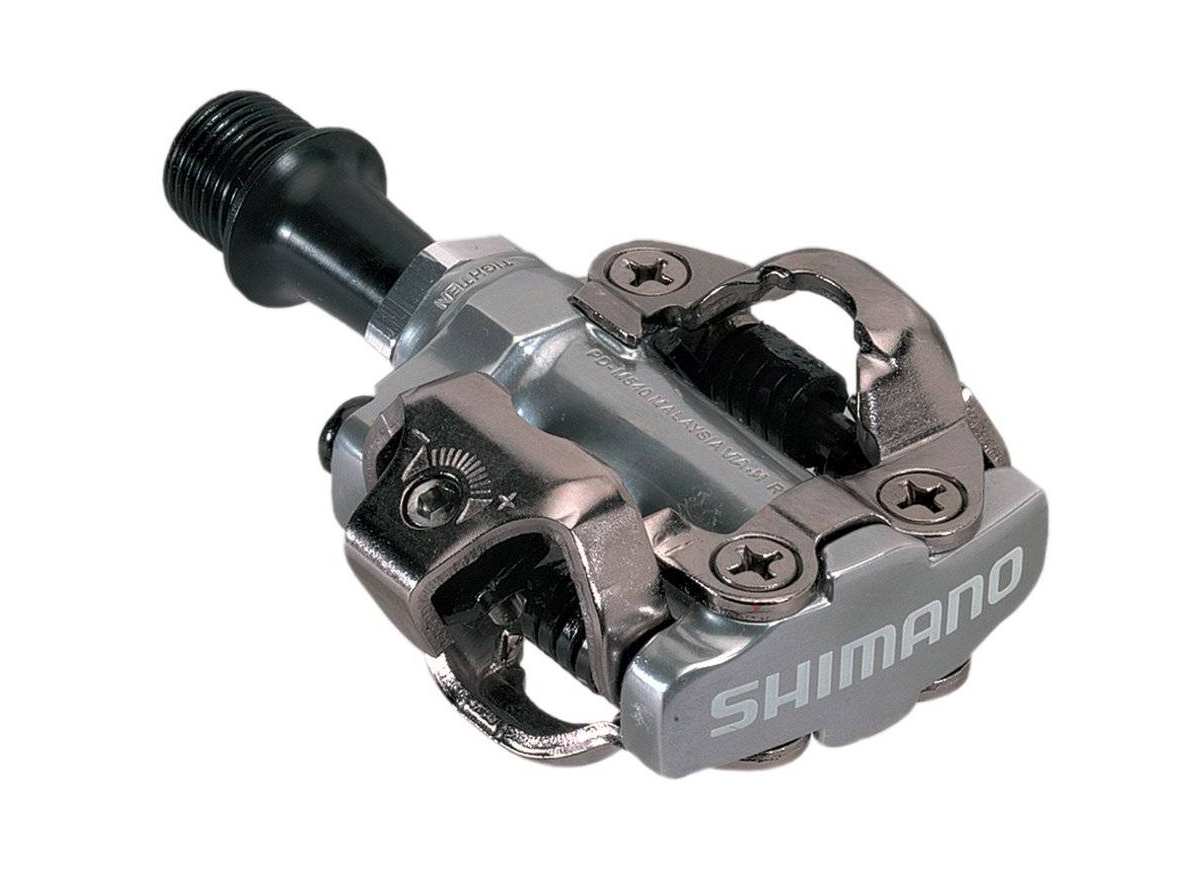
Shimano PD-M540
Specifications
Reasons to buy
Reasons to avoid
The Shimano PD-M540 takes the M520 body and ‘upgrades’ it with a lighter, sculpted axle to save 11g of weight from each pedal. That’s not a massive amount considering they generally sell for around £10 more. While the 8mm Allen key axle looks slick you can’t use a 15mm spanner to fit/remove the pedals either. You do get a metal bearing collar rather than the plastic one on the 520s though which means you don’t need the matching collar removal tool.
If they seize in place (which they can do) there’s no option to melt it out and fit a new one like there is on 520s. Otherwise, the bearings are the same user-serviceable, relentlessly reliable arrangement. Despite having used far more of them, we’ve definitely had fewer issues with 520 and 540 pedals over the years than pricier XTR units so, in comparative terms, they’re still a total bargain.
As the mechanism sits on top of the body rather than embedded, there’s more sideways wobble and play between shoe and pedal than larger platform options. The mechanism is also more exposed and there are fewer cleat options than some competition as the ‘multi-release’ is a lot less predictable than a simple increased float design.
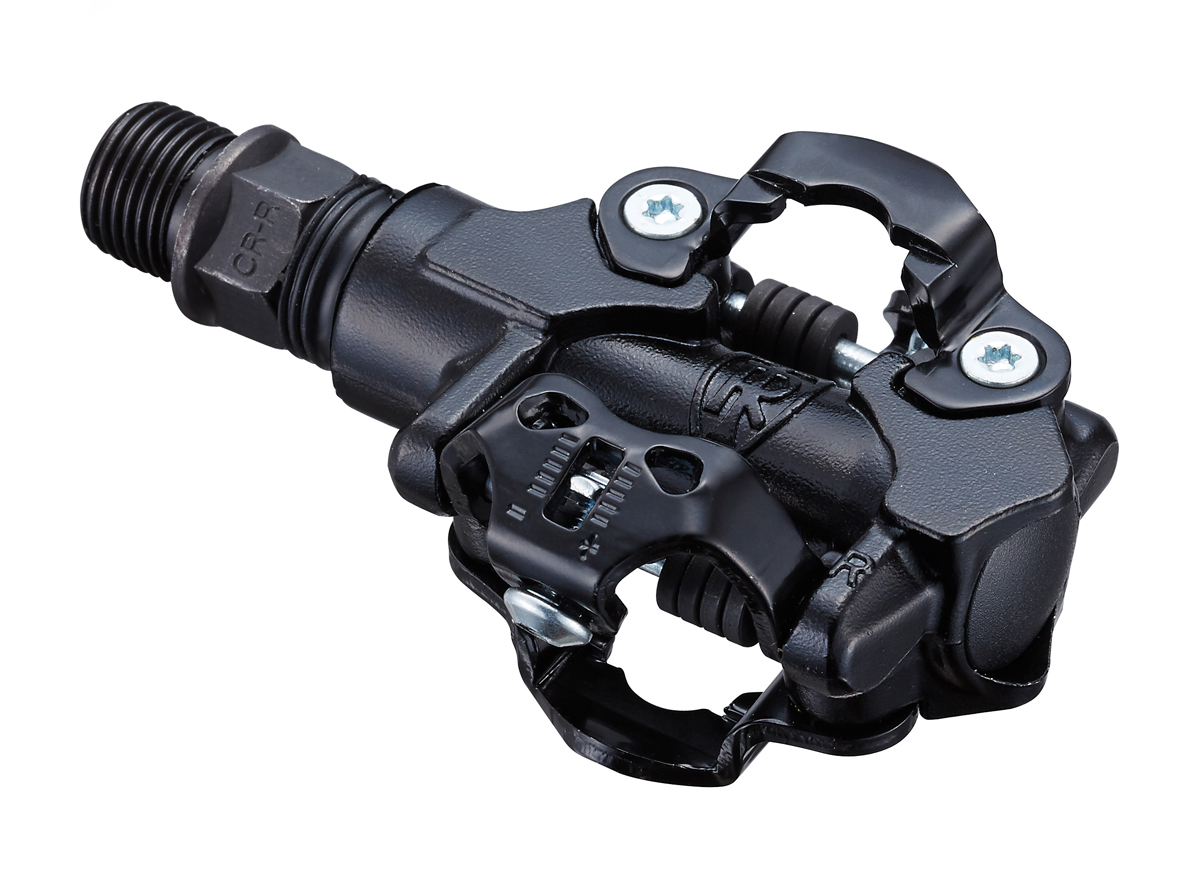
Ritchey Comp XC
Specifications
Reasons to buy
Reasons to avoid
Ritchey has a reputation for lightweight racer friendly components and even its entry-level Comp pedals are significantly lighter than most. The gram shaving mostly comes from the minimalist cold-forged body with a bolted-on front catch. There’s still enough side support for stiffer shoes though but with no shim system the tightness of that connection varies on shoe tread design/depth. There is a ‘trail’ version with extended front and rear cage if you want more cage under your midfoot though.
It’s worth noting that they normally come with tension set to minimum. That’s a nice touch for beginners but you’ll need to add some clicks if you don’t want your feet to fly off too easily.
Ball bearings inboard and outboard give a decent run life and they can be regreased and serviced if they do start to get dry or wobbly. The WCS version uses needle bearings, bushings and a cartridge bearing to drop another 35g. If weight isn’t an issue for you, though, they both look expensive compared to the indestructible Shimano competition.
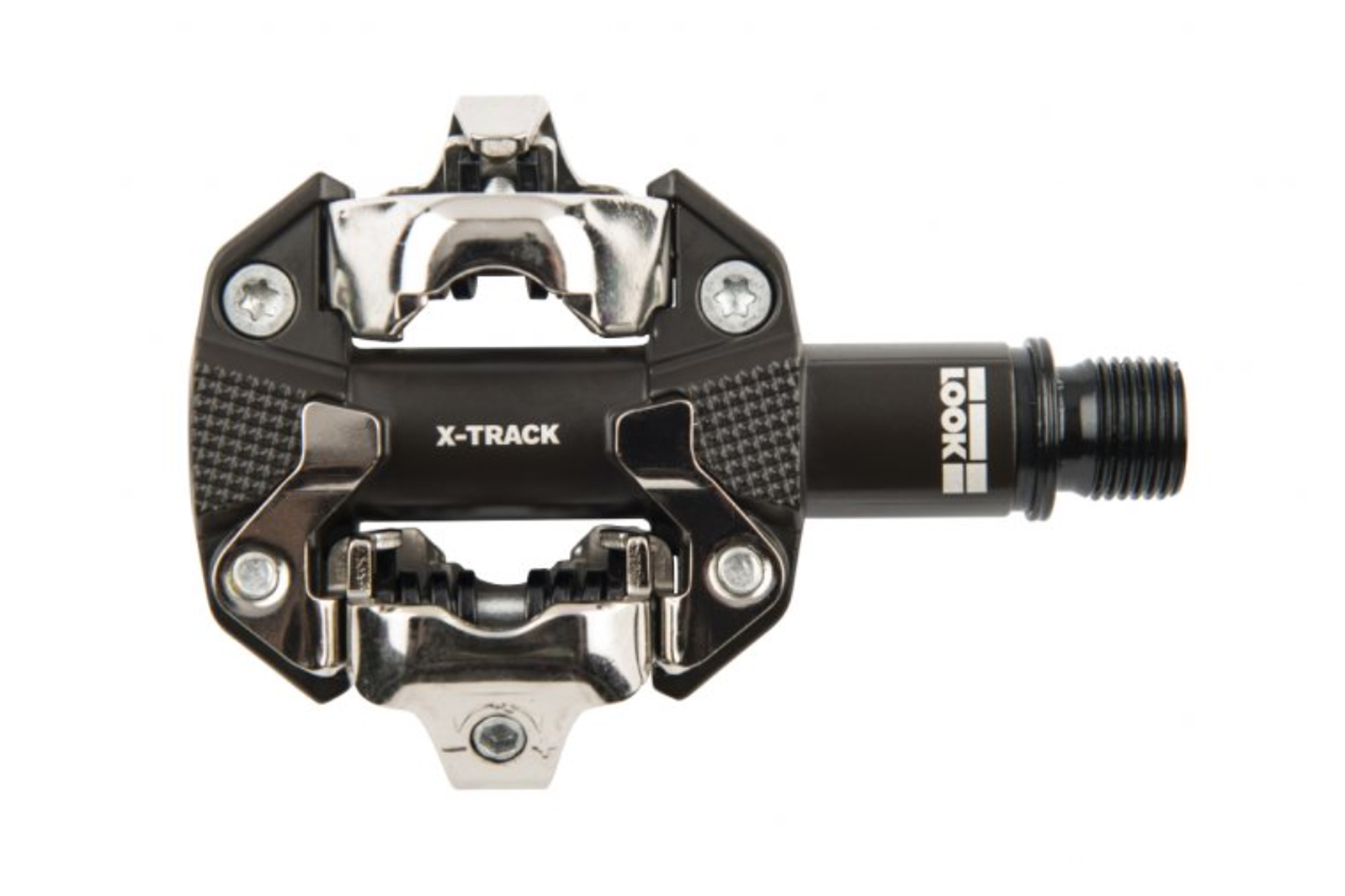
Look X-Track
Specifications
Reasons to buy
Reasons to avoid
Look's take on an SPD-compatible pedal carries over the brand's expertize in road bike pedals. So there's a robust build and the bearings are rock-solid, even after thousands of miles of use in the usual muddy/dusty/wet mix of conditions. The black anodizing on the standard pedals tends to wear over time, but the metal bodies cope well with bashes and abuse.
The platform is a bit wider than more minimalist pedals like the Ritchey and the Shimano models, so there's decent shoe support from the gridded side areas. That does mean that there's a bit more tendency to clogging, however, although it's not any worse than on other designs.
Like other SPD pedals, there's easy adjustment of release tension. and the open springs continue to work well. Look supplies its own cleats, which are durable and give six degrees of float. There's also an easy release version available with multiple release directions, rather than just the side-to-side of the standard cleats.
The more substantial design means that the Look X-Track pedals are a bit heavier than some XC/trail pedals, although you can shave a bit off by opting for the pricier carbon bodied and titanium spindle models.
What to look for in the best cheap MTB pedals
How important is price when looking for the best cheap MTB pedals?
Pedals are one area of your MTB set-up where spending more doesn't necessarily equate to a better product, though it it does tend to get you more choice. More sculpted bodies and improved axle material can reduce the weight, but generally also increase the cost.
It's worth noting, however, that a more expensive or complex MTB pedal won't necessarily be more reliable. In fact, Shimano's cheapest pedals tend to outlast pretty much any pedal from anyone else, despite sometimes being sold for less than a spare pair of cleats – which, coincidentally, they come with as standard.
Clipless or flat?
Clipless or flat is a perennial question in MTB circles and depends greatly on personal preference and the type of riding you're doing.
If you're looking to put in some serious miles on the track, chances are you'll want a secure connection with your bike to allow for maximum power transfer to your wheels. If that's the case, a clipless pedal, which allows you to attach your shoe to the pedal, will probably be on your shopping list.
MTB flat pedals, meanwhile, are likely to be the best option if you want undiluted trail feedback, and prefer being able to shift your feet while you ride. The fact that you're not physically attached to your bike can also be beneficial in the event of a crash, though it's worth noting that flat MTB pedals tend to work best when paired with MTB flat pedal shoes.
What size of pedal do I need?
If you're going clipless, larger pedals will be easier to find with your feet, as well as providing more support under your shoe. This tends to make the pedal heavier, however, and really big platforms tend to be used mostly by gravity riders. At the other end of the spectrum, 'skeleton' mechanism-only clipless pedals are superlight and more-or-less impervious to mud clogging. That said, with very little in the way of support platform or protection, they're best suited to very stiff shoes and more careful riders.
If flat pedals are you're preferred option, bigger is generally better. This is because larger pedals provide a greater surface area for adjusting your feet, while the larger contact area spreads impact forces in drop-offs and jumps. However, increased size can be a catch (literally), as pedals that are too large are more likely to strike rocks and tree stumps as you ride. We recommend trying before you buy – if there's lots of pedal sticking out from under your shoe, try a smaller model.
What material should I look for?
With clipless pedals, there's a degree of correlation between the material used and the price you pay – more premium models might feature better quality steel, perhaps, or even titanium if you want to get super fancy. Your pedals will be lighter but chances are they'll cost you more.
When it comes to flat pedals, meanwhile, most premium models are made from light, durable aluminum alloy. Plastic models tend to be cheaper, with some brands offering versions that are exact size/shape replicas of their metal brethren. It's also worth noting that the pins which enhance the grip between a soft compound rubber mountain bike shoe and a flat pedal are easier to replace on a metal body.
Richard has 20 years of experience as a journalist and editor, and spent most of that time geeking out on market-leading sci-fi and fantasy magazine SFX. Since standing down as editor to go freelance in 2019, he’s continued to write about Star Wars, Star Trek and other movies and TV shows for the likes of SFX, Total Film, GamesRadar+ and TechRadar. He also played a pivotal role in the launch of outdoor site Advnture as managing editor, and regularly helps out with production on Bike Perfect. Much as he loves being in the saddle, Richard realized early on that he prefers going up hills to down them – especially when there are trees involved.
- Guy KestevenTechnical-Editor-at-Large
- Rich OwenEditor, BikePerfect
- Sean FishpoolFreelance writer

